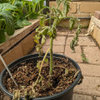Veticulum, Fussarium, overwatering, overfertilizing???What is it!
I have been planning my 22 varietal 24 plant Heirloom tomato garden since last November. I have 6'5" cages and have been dreaming of filling them.
Most of my plants are 4-5 feet, and some are 6-7 feet. All looking healthy and happy. Then they started dying.
I was fertilizing every 10-14 days with organic liquid fertilizer 4-3-3. I water every 3-4 days with drip line in raised beds.
A few weeks ago I went on a business trip and my better half forgot to water the garden, so the night before I came home he let the drip system run all night. Since he had all of the valves open the pressure was very low, so I didn't think it would be an issue. We live in the Santa Cruz Mountains, and so it gets warm during the day.
Two weeks ago we went on vacation and we watered intensively to be sure the plants could go the 6 days we were gone. We were worried about the heat of the day. It can get into the 90's here.
My plants are now in decline. A part of me thinks it is overwatering and fertilizing, and another part thinks fungus.
The leave turn a dark green, and then brown and then die and shrivel. This is starting at the bottom and working its way up. The flower branches durn brown and lignify. I have been cutitng off dead tissue, and the tops to many of the plants look healthy and have yellow flowers, etc. Some of them even have new shoots growing from the base that is practically naked from dead leaf pruning, which leads me to think this is not fungus.
I have look at many pictures, etc. on this forum and others and am still very confused and depressed. Any advice or suggestions appreciate.
I will try to attached photos. Looks like I can only attach one photo, so I tried to pick the one with the overall aspect of decline. You can see some brown leaves that are dried and some green leaves. The more I prune dead tissue the more exposed the tomatoes are. Some of my plant are tomatoes hanging on a branche with a few leaves at the top because everthing else has died.
Image link:








srodemsOriginal Author
torquill
Related Professionals
Birmingham Landscape Architects & Landscape Designers · Glen Ellyn Landscape Architects & Landscape Designers · Seabrook Landscape Architects & Landscape Designers · Arlington Landscape Contractors · Arden-Arcade Landscape Contractors · Athens Landscape Contractors · Beachwood Landscape Contractors · Dallas Landscape Contractors · Euclid Landscape Contractors · La Vista Landscape Contractors · Monterey Landscape Contractors · Mount Kisco Landscape Contractors · Maple Heights Landscape Contractors · Agoura Siding & Exteriors · Euless Siding & Exteriorsjean001